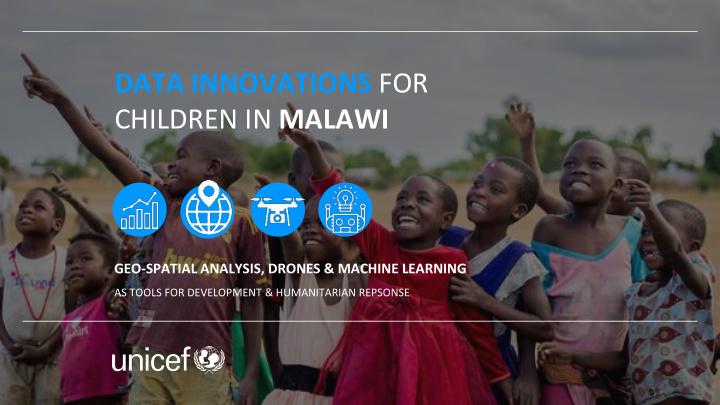



DATA INNOVATIONS FOR CHILDREN IN MALAWI GEO-SPATIAL ANALYSIS, DRONES & MACHINE LEARNING AS TOOLS FOR DEVELOPMENT & HUMANITARIAN REPSONSE
WHY INNOVATE IN MALAWI CHALLENGES AFFECTING CHILDREN & THEIR FAMILIES: • One of the poorest countries in the world • Over 80% of the population live in rural areas Health • High maternal mortality rate • Malnutrition, malaria, HIV/AIDS • Cholera outbreak Emergency & Climate Change • Annual flood, annual famine • Lack of access to water Need to work beyond business as usual!
The role of drones I M A G E R Y C O N N E C T I V I T Y T R A N S P O R T Supply Chain efficiency Landslide risks Post-emergency cell/Wi-Fi Rapid disease diagnosis Water resources Air Coordination UTM Damage assessments Counting Displaced people
T R A N S P O R T
C O N N E C T I V I T Y
I M A G E R Y
DRONES + MACHINE LEARNING GLOBHE & IBM WATSON • Tests in the Malawi drone testing corridor • focuses on technology for imagery & mapping; • Feeds drones captured images to IBM Watson to recognize different plants and seasonal changes through AI and image recognition
ORTHOMOSAIC KASUNGU The Kasungu site is a densely populated urban area, covering several neighborhoods, parts of major road network and infrastructure (e.g schools, health delivery points, house of worship). Area: 7.15 km² Images: 6082 Size of data: 5.3MB per image Number of flights: 27 in order to generate the desired 2D and 3D maps Processing time: The actual processing time has been between 5 - 10 min per image due to limited internet connectivity at that time which was heavily attributed by the power situation
IMAGE ANALYSIS – How Does It Work? Artificial Intelligence (aka algorithms) gets trained to recognize certain features in pictures through the use of “classifiers” and applies this logic to new pictures
IMAGE ANALYSIS – Data Generation This process helps to generate (statistical) data out of pictures and helps you to draw conclusions and make according recommendations For example: SDG Indicator 6.2.1 - Proportion of population using safely managed sanitation services , including a hand-washing facility with soap and water The map shows latrines with a 50m radius circle and provides an insight into the access to sanitation in this area. At this test, the confidence level is at 70% as some detections might be missing (or falsely detected) - but with more training time the accuracy will improve.
DATA FOR CHOLERA RESPONSE GEO-SPATIAL + DRONES + MACHINE LEARNING APPLICATIONS 2a. Drone acquired imagery used for community engagement 1. Community sensitization 2. Drone data acquisition 3 . Ground truth data acquisition by LUANAR students (sample of data on cholera related features) 6. Results dissemination 4. Artificial Intelligence 5. Data analysis and used to identify cholera identification of potential related features cholera hotspots
Questions & Feedback Thank you from UNICEF Malawi Michael Scheibenreif | mscheibenreif@unicef.org
Recommend
More recommend